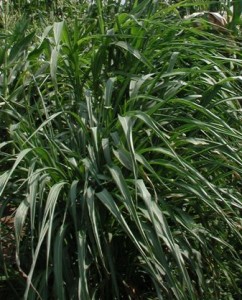All corn, or maize, is genetically modified. It began 6,000 to 10,000 years ago as a wild grass called teosinte. It was nothing like the tasty ears of corn we enjoy now, the seeds were hard and small with only about 5 to 12 seeds.
It looks more like something you would take a string trimmer to than it does an important food crop, doesn’t it?
Early Mesoamericans (people who lived in what is now Mexico and Central America, before Europeans came) bred the plants over thousands of years to get plants that were closer to what we think of as corn.
Modern corn needs people as much as people need it. If an apple falls off an apple tree, the fruit will rot and the seeds will have a chance of sprouting. If a corn cob full of corn falls off the plant the seeds are too tightly wrapped to be able to sprout. Even if it was shucked first, there are too many tightly spaced seeds. It would not have the room it needs to grow.
Corn growers realized they could breed together several varieties of corn and create hybrids that combined the most desirable qualities of the ancestor varieties. According to the U.S. Department of Agriculture, “About 95 percent of our corn acreage now is planted to hybrid corn. We produce at least 20 percent more corn on 25 percent fewer acres than in 1930, when seed of hybrid corn became available in quantity to American farmers.”
Hybridization let us develop corn that was more vigorous, disease resistant, had shorter growing periods, and was sweeter. New seeds had to be bought each year since you cannot grow the same plant from the seeds of a hybrid. The plants from its seeds will revert back to the parent varieties.
Corn that had been genetically modified in a lab was first made commercially available in 1996 by Monsanto. There have been several genetically engineered modifications to corn:
- Herbicide tolerant – This lets farmers use an herbicide that kills weeds without harming the crop. This helps prevent soil erosion because the lands needs less tilling to destroy weeds.
- Bt toxin production – A toxin that is produced by a soil bacterium is inserted into the plant. It is harmful to insects that try to eat the plant but is not harmful to humans or animals. It reacts with the alkaline insides of the insect (our stomachs have acid). An extract of this toxin is used in organic farming. Using plants with this modification means the farmers can use less pesticides.
- Starch breakdown – This GM corn contains a transgene for an enzyme that breaks the starch in the corn down into maltose. This speeds the corn’s production into ethanol.
Corn and other plant hybridization helped feed the world for a while, but to keep growing we need to continue to develop genetically engineered plants that provide more food, use less resources, and are more environmentally friendly.
Learn more about teosinte from the University of Wisconsin and the history of maize (corn) from History.com
NYT article about the history of corn
Find out the myths and truth about GMO corn from NPR
Read a post at the Skeptical Raptor’s Blog with lots of links to learn about GMO science vs. anti-GMO fear mongers.


